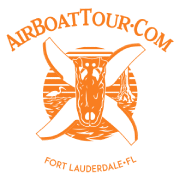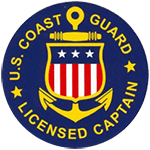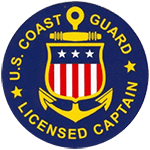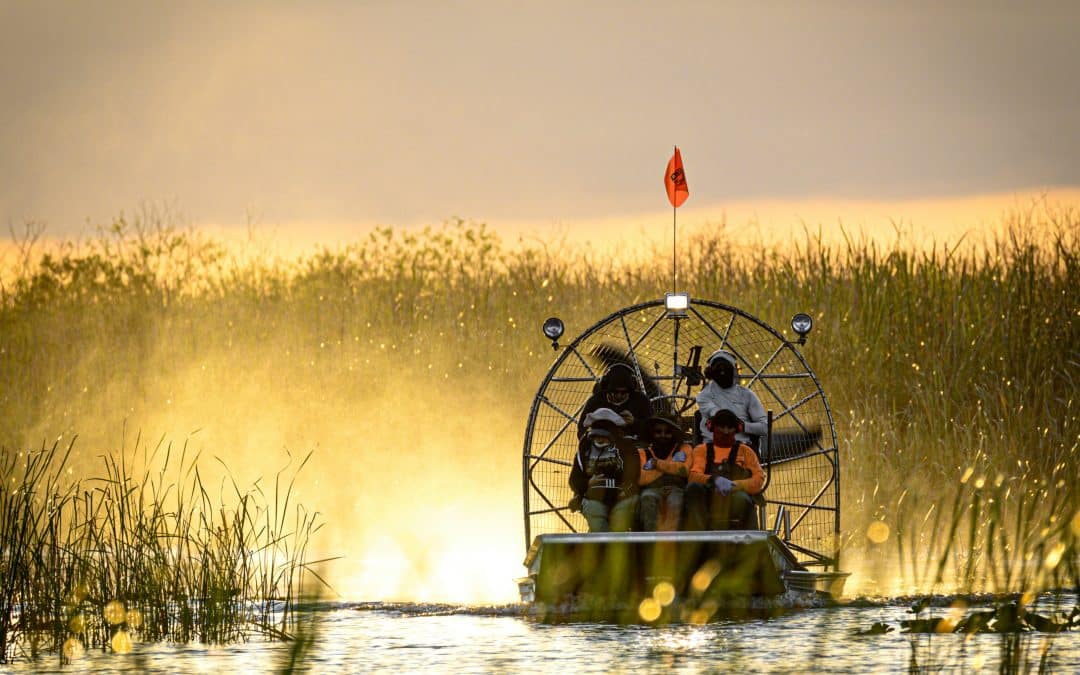Ever wondered about the history of airboats? The Florida Everglades brings to mind images of lush wetlands, sawgrass prairies, and an abundance of wildlife. But navigating this river-filled region requires a specialized mode of transportation designed for the task – the airboat.
With a flat-bottomed hull and a large propeller, airboats sit on a cushion of air, able to cut through vegetation and skim over shallow waters with ease. What you may not know is that the history of air thrust boats is just as unique as the ride itself!
Let’s take a closer look at airboat history – and how you can take a ride on the water in style with Everglades Airboat Tours!
What Is An Airboat?
An airboat (also called an air thrust boat) is a type of boat propelled by an aircraft-style propeller.
Unlike traditional boats, airboats do not have a submerged propeller or rudder and instead use a large fan-like propeller mounted above the waterline. This design allows for maximum maneuverability in shallow waters, making it the perfect mode of transport for navigating the Florida Everglades.
Commercial airboats generally sail at speeds of up to 30 miles per hour, making for an exhilarating ride through the wetlands. With their flat-bottomed design and lightweight materials, airboats can easily glide over marshes, sawgrass, and other vegetation without causing any damage.
Swamp boat tours are a fun and unique way to explore the Florida Everglades. These tours are led by experienced captains who have grown up navigating the waters of the Everglades. They offer a one-of-a-kind experience, taking visitors through some of the most remote and untouched areas of this natural wonder.
A Look At The History of Airboats
Early Airboat Experimentation
The history of airboats is a fascinating tale! The inception of airboats dates back to 1905 when Glenn Curtiss, an aviation pioneer, built an aircraft prototype with a step-hull frame and push-propeller system with the goal of designing a flying boat.
The first airboat failed as a seaplane but demonstrated capabilities for skimming over the water’s surface. Local legend claims that in 1911, famous inventor Alexander Graham Bell experimented with Curtiss’ design, constructing a metal frame with a large rear propeller. Though intended as an ice boat, Bell’s first trials propelling over the water’s surface led to the creation of the earliest airboats.
Over the next decades, airboats continued to evolve, mainly serving utilitarian transportation needs. In the 1920s, the U.S. Army Corps of Engineers operated airboats to survey flood control waterways.
By the 1930s, airboats became vital vehicles for oil drillers to access remote drilling locations in Louisiana’s Atchafalaya River basin. The addition of aircraft engines and metal hulls through the 1940s improved speed and durability. Airboats transitioned from exclusively industrial craft to recreational vehicles by the 1950s as enthusiasts created racing leagues and competitions.
Modified Airboats Tailored to the Everglades
What makes airboats so well-suited for Florida’s Everglades? With its heavily vegetated marshes and winding shallow waterways, accessing the Everglades poses difficulties for standard motorboats.
Airboats, however, skim right over these obstacles, essentially floating on a cushion of air. This unique capability enables them to overcome barriers that leave much of the Everglades isolated.
In the 20th century, airboats enabled critical Everglades exploration and research that shaped environmental protection policies. Scientists utilized them to collect botanical specimens from remote hammocks and tree islands and survey endemic wildlife.
Airboats were essential for managers and rangers with the National Park Service when Everglades National Park was established in 1947. The propeller-driven boat power allowed for deeper access into the mangroves and marshes, providing a better understanding of the complex ecosystem.
Today, airboats continue to play a crucial role in Everglades conservation efforts. Their ability to navigate through shallow and dense water allows for the monitoring of endangered species, such as the American crocodile and Florida panther.
Over time, airboats became intrinsic to Florida Everglades culture through commercial fishermen and hunting guides who used them for transportation and accessing remote areas. Even as extensive drainage projects encroached on natural wetlands through the mid-1900s, airboats kept the vast interior accessible.
As interest grew in protecting endangered habitats in the late 1900s, entrepreneurial airboat operators started ecotourism businesses showcasing the beauty of the Everglades to visitors. Airboat rides transformed from solely utilitarian to sightseeing tours focused on conservation education and wildlife viewing.
Ecotourism and Airboats Today
Today, tour companies provide opportunities to see alligators, turtles, wading birds, and other creatures up close. With environmental awareness and ecotourism on the rise, educational airboat rides enable visitors to appreciate the majesty of the Everglades while supporting ongoing conservation efforts.
From early homemade air thrust boats to modern airboats, designs continue advancing dramatically. Current airboats have aluminum or fiberglass hulls for reduced weight and coated fans for less noise.
More powerful aircraft engines allow for greater speed and passenger capacities over 20. Safety features like structural roll cages and padded seats make recreational airboating accessible to novices and skilled captains alike.
Compare the first ramshackle prototypes cobbled together in the early 1900s to contemporary custom airboats, and the transformation is remarkable. Advancements enhance rider safety while retaining critical capabilities for accessing remote sections of the Everglades. These modern airboats make venturing deep into marshes possible for conservation-minded ecotourism companies.
Experiencing an Untamed Landscape by Airboat
Visitors may come to the Everglades to see alligators and other wildlife, but many discover a new appreciation for the subtler aspects that make this wetland ecosystem unique.
Experiencing scenes only accessible thanks to airboats reveals a different side of the region. Airboat rides capture imaginations, whether admiring their engineering, embracing the thrill of racing across sawgrass prairies, or absorbing panoramic views of untouched habitats.
Through ongoing conservation efforts, key areas and habitats in the Everglades remain protected yet accessible via airboat. This allows companies to responsibly showcase the diversity of landscapes and endemic species to visitors.
Tour options range from one-hour to full-day adventures covering different sections of Everglades National Park and Big Cypress National Preserve. Knowledgeable guides share insights on habitats, animal behaviors, and research activities while navigating to prime areas to view alligators and tropical birds.
Airboats unlocked the mysteries of the Everglades over a century ago but still remain the ideal way to traverse the marshes. Understanding this legacy magnifies an appreciation of the vessel’s ingenuity and the people keeping traditions alive through ecotourism whether a historian or outdoor enthusiast, witnessing the majesty of the Everglades by airboat offers an unforgettable perspective.
Experience the Everglades by Airboat
Glide with us down the river of grass for a one-of-a-kind Everglades airboat tour. Our captains are highly experienced guides who grew up navigating these wetlands. They expertly pilot custom airboats to access remote areas and get you as close to wildlife as safely possible – and you might learn a bit of the history of airboats along the way!
Choose between 1-hour or 2-hour private tours. The longer ride maximizes wildlife sightings of alligators, tropical birds, turtles, and more while revealing the Everglades’ beauty. Bring cameras and binoculars to capture unbelievable up-close encounters!
As advocates for this fragile ecosystem, we aim to educate visitors while providing responsible, ethical Everglades access. Allow our passion for this landscape to inspire your own as we float over the river of grass, sharing cultural history and conservation efforts vital for protecting native species.
Join us for memories to last a lifetime exploring one of America’s most vital, vulnerable wild places. Contact us today at 954-260-1096 or book your airboat adventure online! We can’t wait to show you the magic of the Everglades!
FAQ
What types of wildlife might I see on an airboat ride?
Common Everglades animals include alligators, turtles, herons, egrets, ibises, hawks, bald eagles, osprey, raccoons, snakes, bobcats, white-tailed deer, and more. Luck and seasonality determine sightings.
Is airboat riding safe for kids?
Yes! With certified captains, kid-sized earmuffs for hearing protection and safe seating, our tours safely accommodate ages 2 and up. We also offer private family tours.
What should I wear?
Light, breezy clothing and sneakers or strap-on sandals work best. Bring sunglasses, hats, sunscreen and cameras! Ponchos are provided in case of rain.
When is the best time of day to see the most wildlife?
Early morning and late afternoon tours maximize interesting sightings when animals are more active. But we have great sightings year-round on all tours!
Do you only go to one area, or are several ecosystems visited?
Several distinct biological communities exist across Everglades National Park, including freshwater sloughs, marl prairies, and mangrove estuaries. Our different-length tours visit a variety of habitats.




